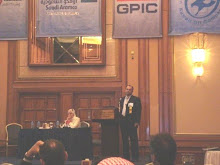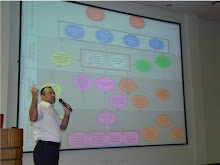Successful Project Management Office (PMO)
There was a global study conducted on 750 Project Management Offices (PMOs) which found that the most successful PMOs were centralized to service the entire organization and they provided added convenience to the project team at the same time (Stanleigh, 2006). To be successful, ten so called ‘secrets’ are recommended. These are:
1. Launch slowly and with careful project planning
2. Create scope statement and Project Plan to ensure a clear and successful, staged implementation.
3. Communicate regularly both internally and with the rest of the organization to garner on-going support from the senior management team.
4. Share and act upon lessons learned, providing regular feedback with/from stakeholders.
5. Effectively manage changes
6. Develop a “stage-gate” approval process for longer-term projects.
7. Simplify methodologies and implement them gradually.
8. Focus on training, mentoring and leading by example.
9. Implement scaleable processes and a simple reporting system to validate compliance with the project management process.
10. Establish project success measures to provide senior management with relevant information for decision-making affecting project completion.
Governance, consistency, quality and transparency are among the PMO benefits. These reflect on project outcomes and organizational revenue.
Another way to look at successful PMO as suggested by Wood (2008) is by identifying common weaknesses that PMO address in organizations, among those:
limited capital and resources
Lack of people dedicated to projects
Lack of objective methods to accept/cancel/terminate projects
Most project managers are really project administrators.
Most project estimates are too optimistic
For a PMO to effectively close these gaps, and be successful, it should:
1. Provide project administration support to project managers.
2. Justify projects based on “worst-case scenarios” in terms to budget, effort levels and completion dates.
3. Deploy standardized techniques and tools for estimating, reporting and project conduct. 4. Streamline paperwork.
4. Make project owners accountable for success of the project.
5. Turn project managers into project execution logicians.
6. Develop a repository of project templates, checklists and expert resources.
7. Adopt a “Once Started-Never Stopped” policy on approved projects
8. Limit the number of tasks that can be active to a person at any given time.
9. Deploy a pragmatic methodology for evaluating, approving and prioritizing projects.
It is important to distinguish the roles of Project Managers from that of a PMO member. Especially when some project managers have dual responsibilities. Therefore, the same PM may have to play a PMO role in some places and PM roles in another. Key identification of each of these roles is shown below. The PMO and the project manager roles are obviously different, but both of them are necessary to ensure the success of the individual project and the success of the overall portfolio of projects.
Finally, it is worth mentioning that it is a challenge to establish and maintain PMO. There is a considerable expenditure expected here and high risks as well. Failing to realise PMO benefits may lead to a state which is worse than the initial one. In my opinion, the following factors should be thoroughly studied at the outset:
• Expected roles of PMO
• Level of formality, authority, and desired structure
• Should the PMO be temporary or permanent
• Should it be built in-house or should we call external consultants/expertise
About The Author

- Eng. Samer el Barakeh, MPM, PMP
- Samer el Barakeh was born in Lebanon, 1973. He completed his Bachelor in Engineering-CCE at Beirut Arab University-Lebanon in 1996 with honours. Samer was granted Masters Degree in Project Management (MPM) from the University of Sydney-Australia with honours. He also gained the Project Management Professional (PMP) Credential from The Project Management Institute (PMI). Samer is a member of the Order of Architects and Engineers in Lebanon since 1996, The Project Management Institute (PMI), Arabian Gulf Chapter (AGC-PMI) and Lebanon Chapter-PMI. During his 13 years of professional experience in Lebanon, Australia and Saudi Arabia, Samer held many positions among them: Telecommunication Site Engineer, Site Manager, Low Current Service Head, and he is currently Senior Systems Analyst at the General Project Construction Division. Samer is a Project Management Consultant and Training Provider for universal organizations like Business Management Consultants (USA) www.bmc-online.com and PMCTQuest (Canada) www.pmctquest.com Samer is a Registered Training Provider for Project Management Professional (PMP), and he provides training in Program Management, Portfolio Management,PMO...
Select a topic to view content
- A comparison between PMBOK and Prince2 Methodologies and reflection on case study examples (1)
- ABC to Avoid Project Failure (1)
- Business Case and Quantitative Benefits (1)
- Do we need more 'Planners' ? (1)
- Fasilitator in Partnering-A Coincise Shot (1)
- How to Ensure Stratgic Alignment of Our Projects? (1)
- Individual Dissimilarity and Team Work (1)
- Knowledge Management (1)
- Maturity Models-The Pros and Cons (1)
- Organizational Advantages from Partnering (1)
- Organizational Maturity: Lets Head Upwards... (1)
- Organizational Strategy and Project Alignement (1)
- Practical Solutions 1 of 6: Introduce RMMM (1)
- Practical Solutions 2 of 6: Facilitate Change to Perk up Maturity (1)
- Practical Solutions 3 of 6: Leverage Organisational Culture Barrier (1)
- Practical Solutions 4 of 6: Organisational Cultural Alignment (1)
- Practical Solutions 5 of 6: Defining a Unified Decision Making Tool (1)
- Practical Solutions 6 of 6: Understanding The Paradox of Control (1)
- Programme Management to Implement Strategy (1)
- Project Management and Construction Management (1)
- Project Managers relocated before Proper Project Closure and Learning Lessons (1)
- Project Managers' Power (1)
- Strategic Planning (1)
- Successful Project Management Office-PMO (1)
- System Thinking: Archetypes at Work... (1)
- The Partnering Change Process (1)
- The Upper Hand… Leadership skills or Processes? (1)
- Thinking about change needed? Maybe you should be more ‘worried’ about how to make it real (1)
- Vision Mission and Objectives What and Why? (1)
- What is meant by Portfolio and Programme Management (1)
- Why Partnering in Organizations? (1)
April 27, 2008
Successful Project Management Office (PMO)
Posted by
Eng. Samer el Barakeh, MPM, PMP
at
7:36 PM
![]()
![]()
Subscribe to:
Post Comments (Atom)
Followers
All Titles
A comparison between PMBOK and Prince2 Methodologies and reflection on case study examples
ABC to Avoid Project Failure
Business Case and Quantitative Benefits
Do we need more 'Planners' ?
Fasilitator in Partnering-A Coincise Shot
How to Ensure Stratgic Alignment of Our Projects?
Individual Dissimilarity and Team Work
Knowledge Management
Maturity Models-The Pros and Cons
Organizational Advantages from Partnering
Organizational Maturity: Lets Head Upwards...
Organizational Strategy and Project Alignement
Practical Solutions 1 of 6: Introduce RMMM
Practical Solutions 2 of 6: Facilitate Change to Perk up Maturity
Practical Solutions 3 of 6: Leverage Organisational Culture Barrier
Practical Solutions 4 of 6: Organisational Cultural Alignment
Practical Solutions 5 of 6: Defining a Unified Decision Making Tool
Practical Solutions 6 of 6: Understanding The Paradox of Control
Programme Management to Implement Strategy
Project Management and Construction Management
Project Managers relocated before Proper Project Closure and Learning Lessons
Project Managers' Power
Strategic Planning
Successful Project Management Office-PMO
System Thinking: Archetypes at Work...
The Partnering Change Process
The Upper Hand… Leadership skills or Processes?
Thinking about change needed? Maybe you should be more ‘worried’ about how to make it real
Vision Mission and Objectives What and Why?
What is meant by Portfolio and Programme Management
Why Partnering in Organizations?

















Did you realize there's a 12 word sentence you can tell your man... that will induce deep feelings of love and impulsive appeal to you buried inside his heart?
ReplyDeleteThat's because hidden in these 12 words is a "secret signal" that fuels a man's impulse to love, idolize and protect you with his entire heart...
=====> 12 Words Who Trigger A Man's Desire Impulse
This impulse is so built-in to a man's brain that it will drive him to work harder than before to build your relationship stronger.
Matter of fact, fueling this mighty impulse is absolutely mandatory to achieving the best possible relationship with your man that the moment you send your man one of the "Secret Signals"...
...You'll immediately notice him open his soul and heart to you in such a way he's never experienced before and he'll identify you as the only woman in the world who has ever truly appealed to him.